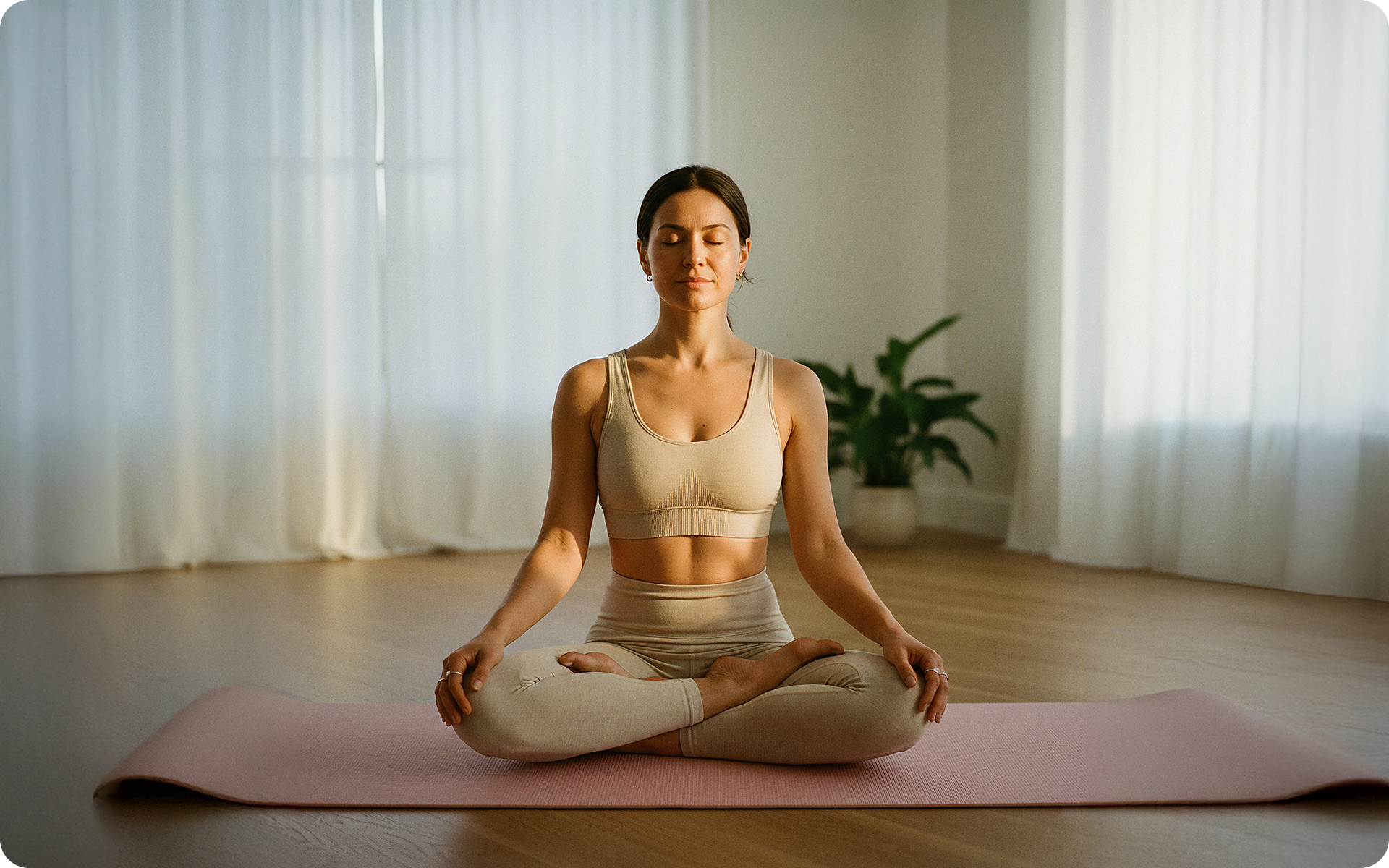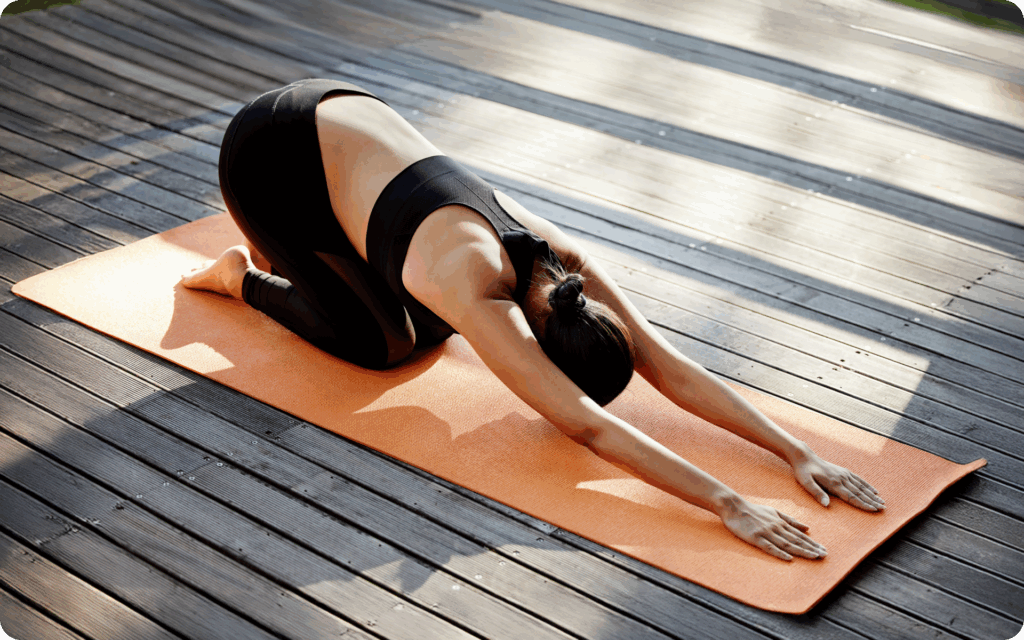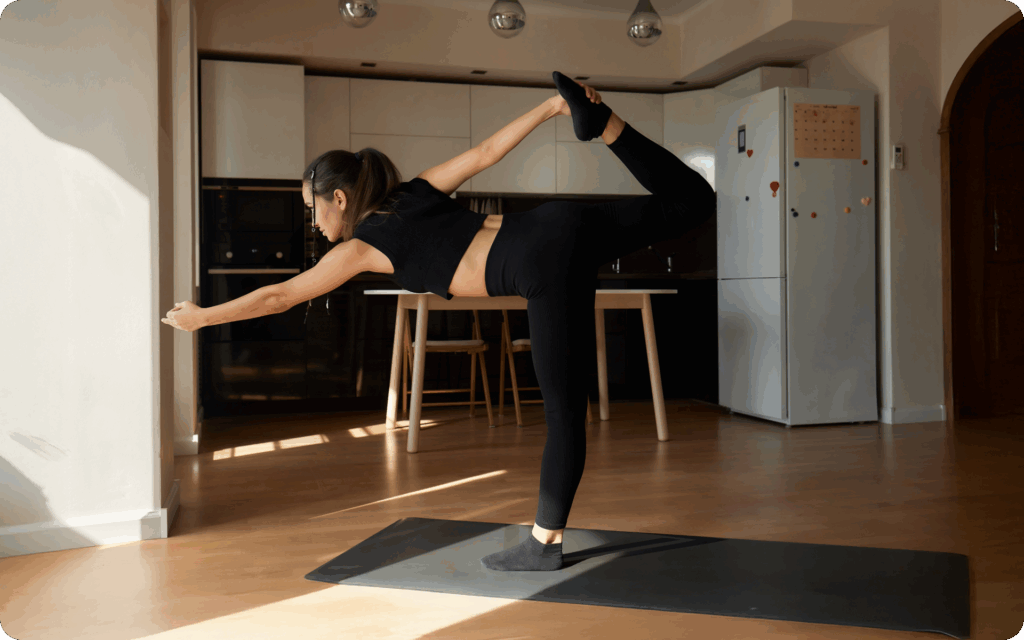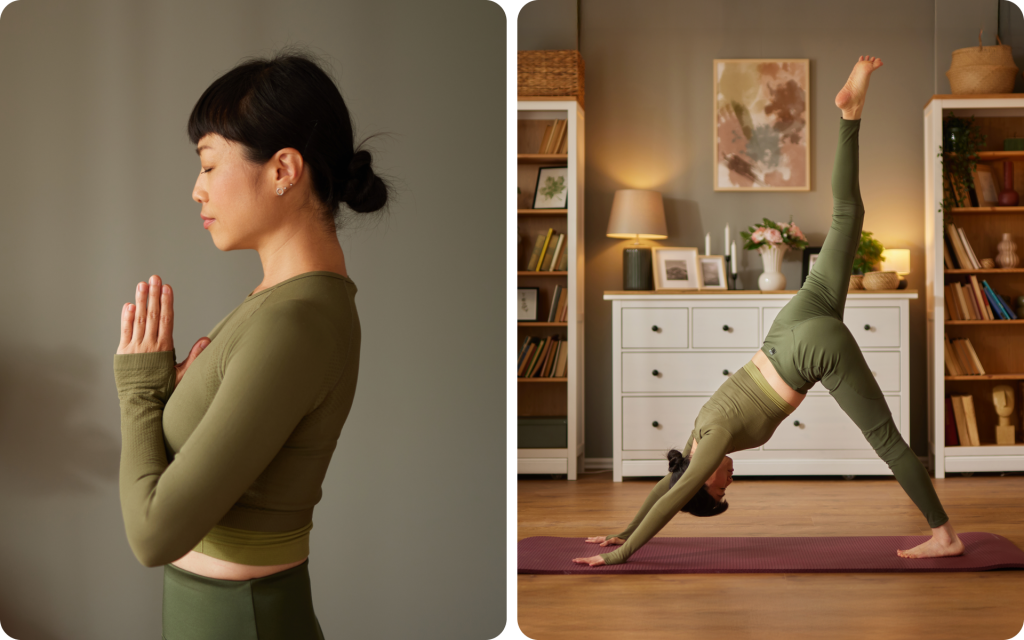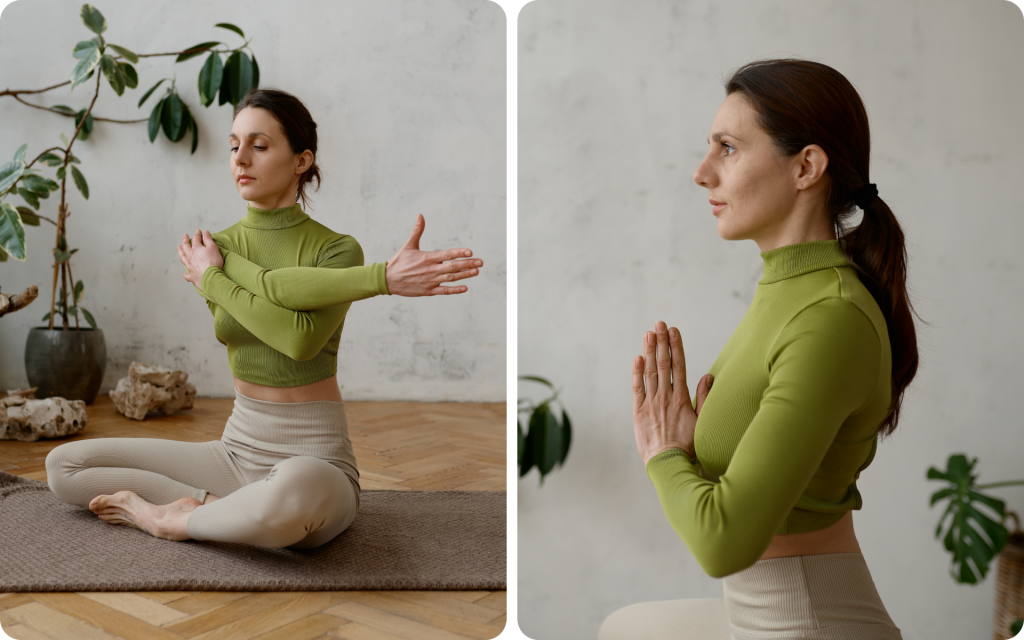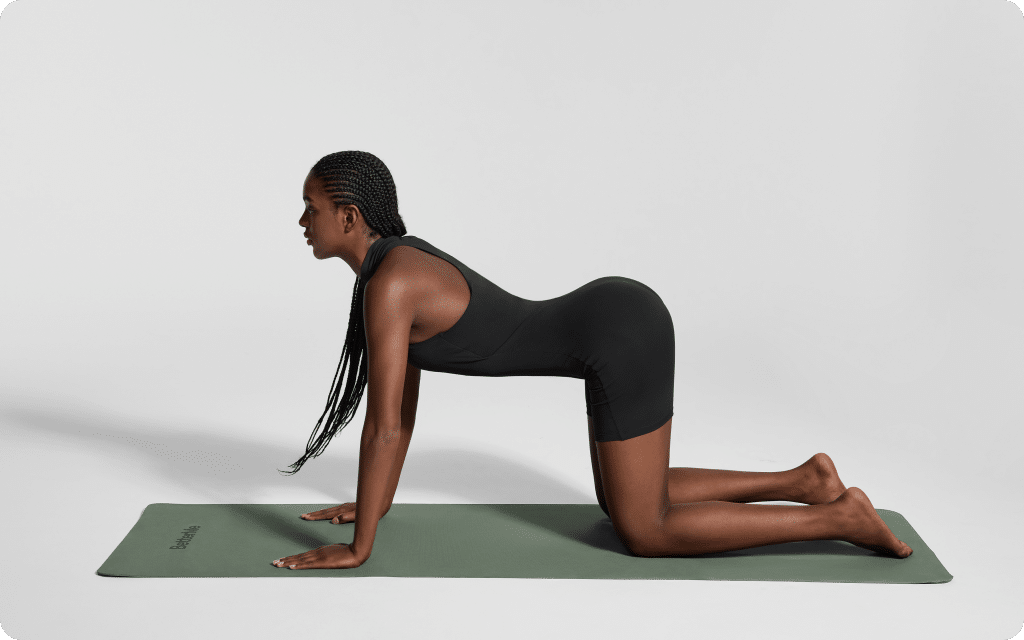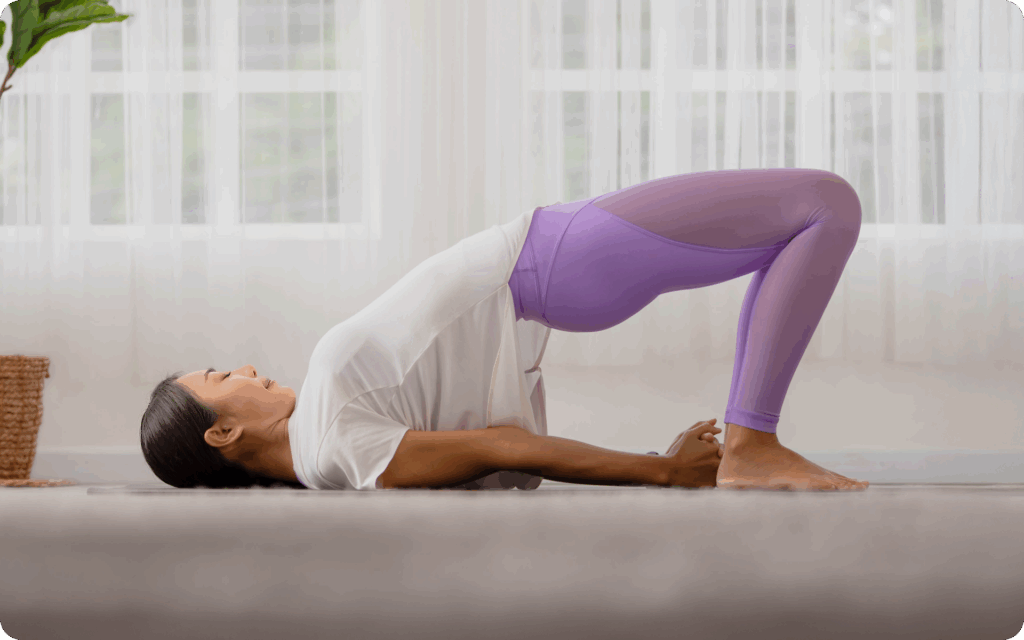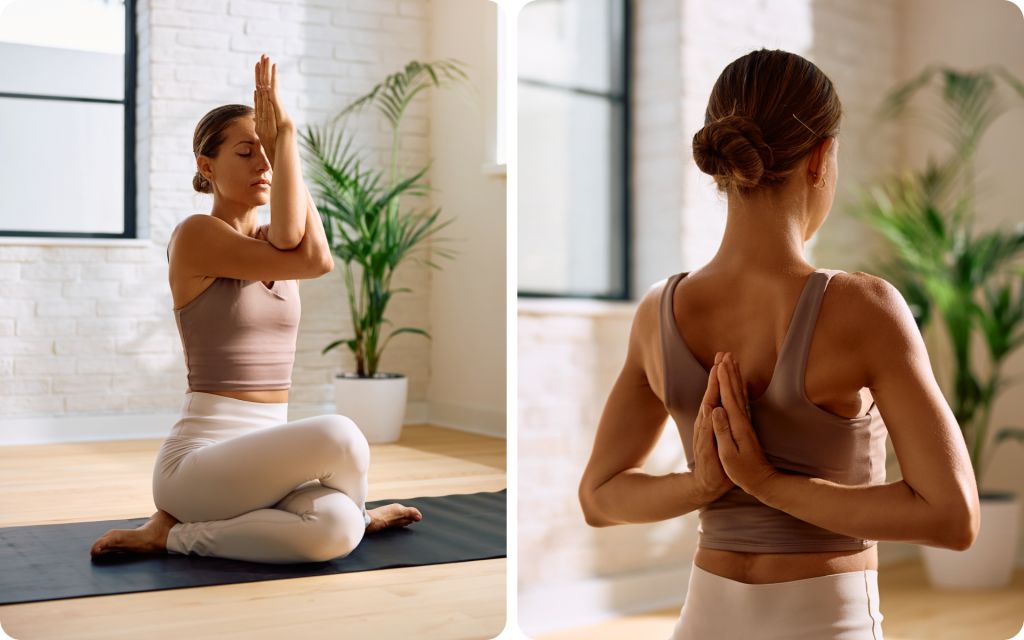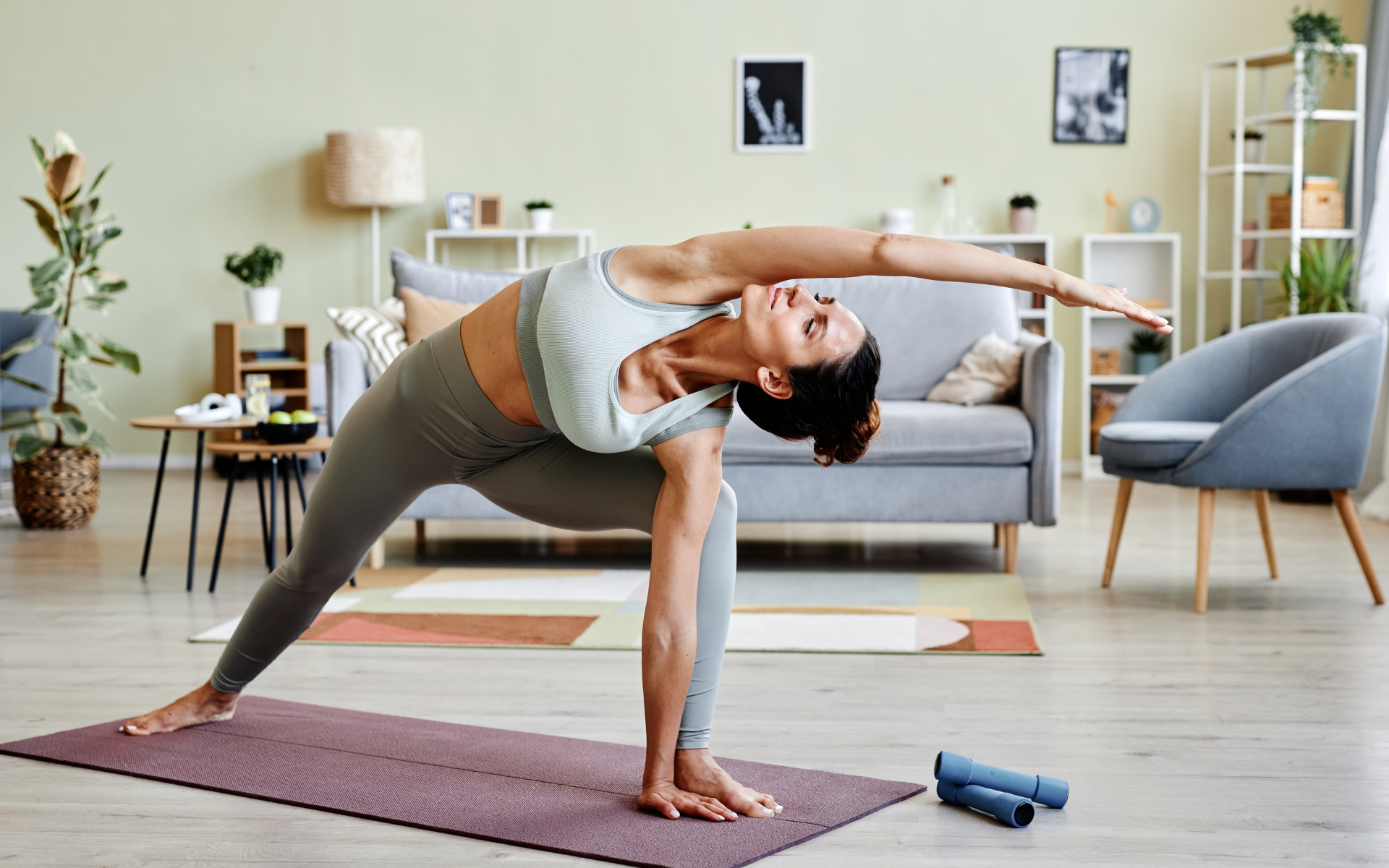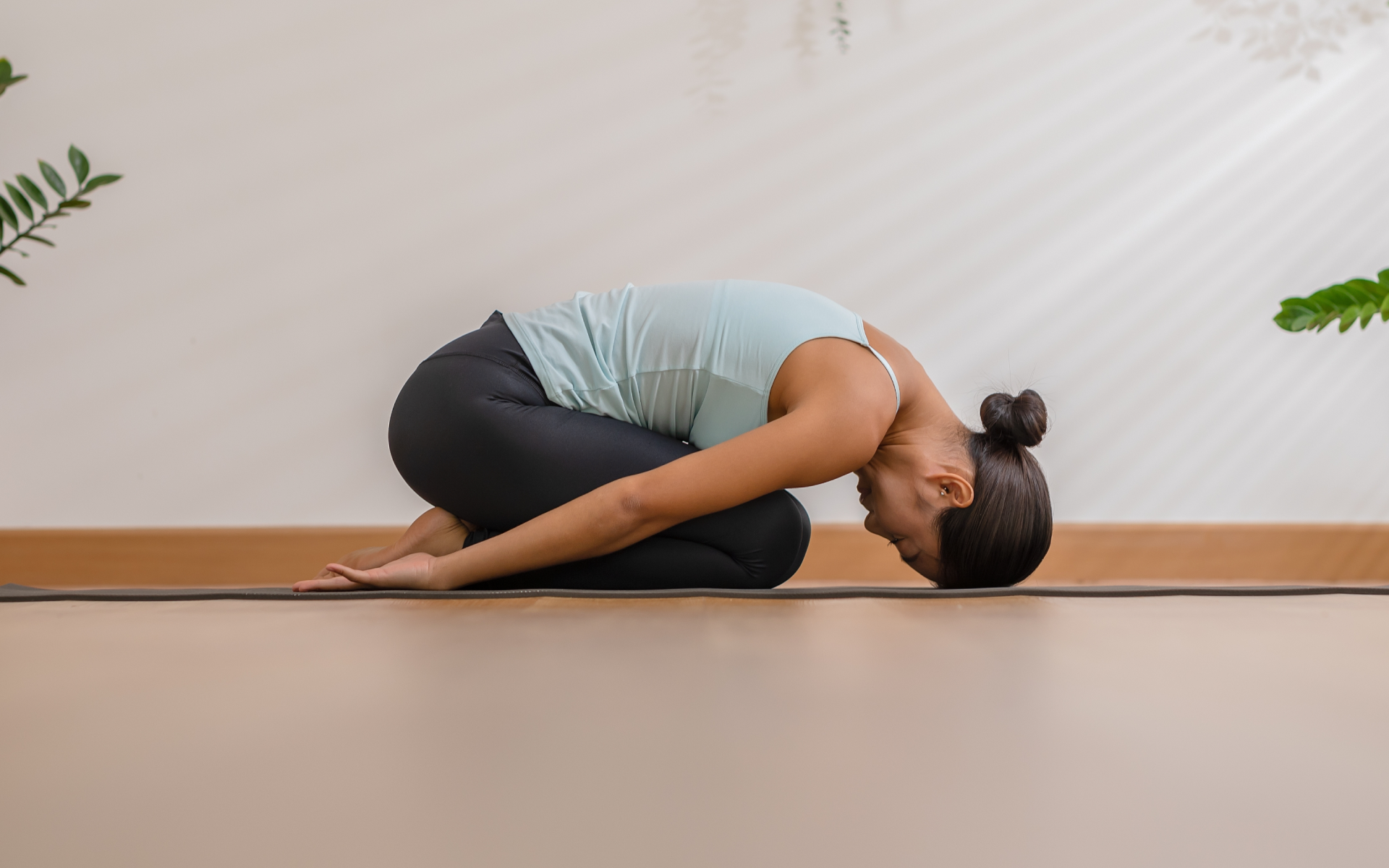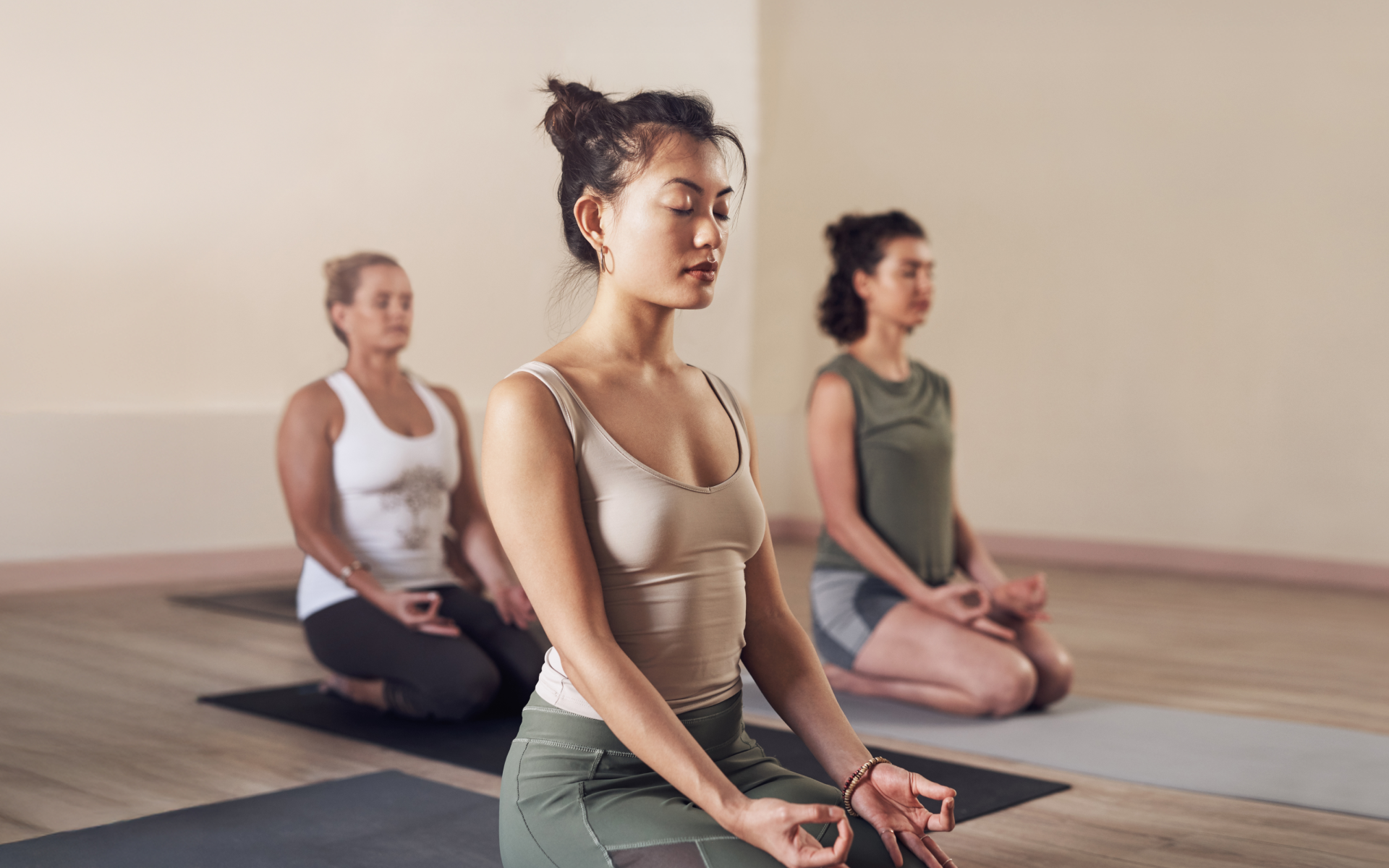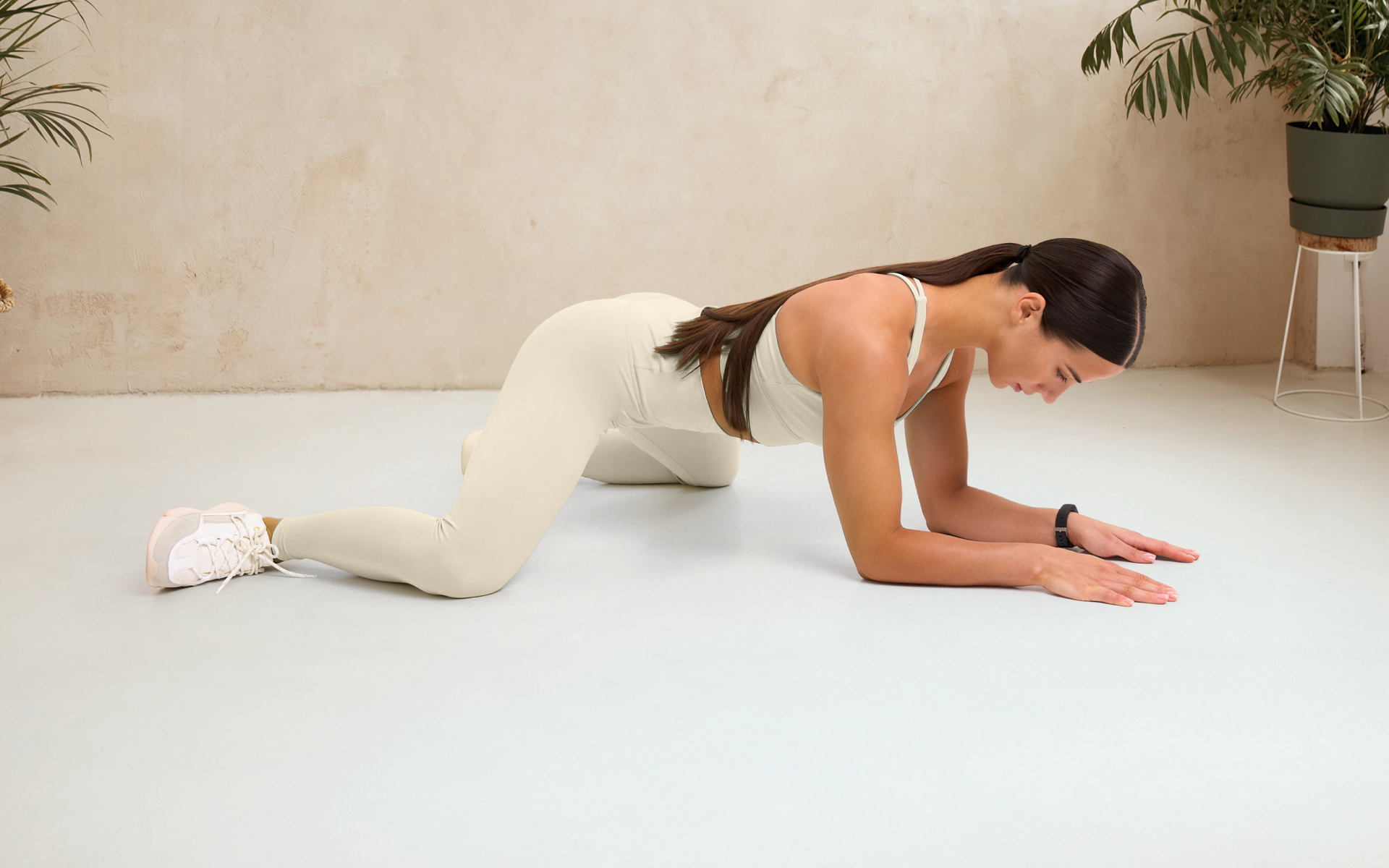Practicing yoga “somatically” involves slowing down and tuning into your body. Instead of pushing to achieve the perfect pose, you focus on how the pose feels and how your body moves into and out of it. You become an active participant in your experience, using micro-movements, focused attention, and proper breathing to uncover and unwind tension.
Over time, this approach can improve physical comfort, increase functional mobility, and foster a deeper connection to your body’s signals.
In this article, we’ll explore six yoga exercises that are suitable for beginners, all of which are practiced through a somatic lens.
These exercises aim to build body awareness, restore healthy movement patterns, and help you tap into a more mindful practice.
Does Somatic Yoga Work for Beginners?
If you’re new to yoga, the somatic approach offers a meaningful way to connect with your body. It prioritizes exploration over achievement, which allows you to build awareness and develop healthy movement habits from the beginning (1).
Here are some of the key benefits of somatic yoga for beginners:
- Improved Body Awareness
Somatic yoga encourages you to slow down and notice the sensations in your body (2). By focusing on how you feel in each movement, you start to recognize patterns of tightness or imbalance. This awareness is foundational. It helps you move more intentionally during yoga and daily activities, fostering better posture and muscular control (3).
- Reduced Tension and Stress
Beginners often approach yoga with unconscious tension in their muscles. Somatic principles teach you how to release this tension incrementally (4). Rather than forcing a stretch or a pose, you explore smaller, more controlled movements that gently retrain your nervous system. Over time, this reduces physical tightness and promotes a sense of relaxation (4).
- Enhanced Movement Patterns
Somatic movement teaches you to move with greater efficiency and ease. This process, which is called neuromuscular re-education, involves reprogramming how your brain communicates with your muscles (5). Moving somatically can help beginners develop movement patterns that are functional and pain-free, which reduces potential harm.
- Mindful Breathing Integration
A core element of somatic yoga is connecting movement with breath. This creates a steady rhythm and helps beginners stay present during practice. Learning to breathe deeply and control your breath also calms the nervous system (6), which makes it easier to manage stress both on and off the mat (7).
- Gentler Transition into Yoga
Many beginners feel intimidated by traditional yoga classes or poses. Somatic yoga removes the pressure to “perform”. Instead of focusing on achieving a perfect downward dog or warrior pose, you focus on how these movements feel in your body. This creates a welcoming, judgment-free space in which you can learn at your own pace.
- Better Connection to Your Body’s Signals
Somatic yoga encourages listening to your body. For beginners, this is an invaluable skill. It helps you notice early signs of fatigue, overuse, or discomfort (8). This self-awareness supports a safer yoga practice and carries into everyday life, promoting healthier movement habits overall.
- Build a Strong Foundation for Lifelong Practice
Practicing yoga somatically strengthens both your understanding of your body and your movement patterns. For beginners, this creates a rock-solid foundation. Rather than focusing on the external goals of yoga, you build an inner confidence and awareness that can deepen your practice over time.
Read more: At-Home Somatic Therapy: Exercises To Regulate Your Emotions
How Do I Start Somatic Exercise?
Starting with somatic exercise can be an empowering and insightful experience. Unlike many forms of physical activity, somatic exercises are about reducing tension, improving movement patterns, and reconnecting with your body. If you’re a beginner, you don’t need any special equipment or advanced knowledge. What you need is a willingness to slow down and really listen to your body.
Here’s a step-by-step guide to help you get started with somatic movement:
1. Find a Quiet Space
Somatic exercises are most effective when they’re performed in a calm, distraction-free environment. Choose a space where you can lie down comfortably on the floor or your bed. Avoid interruptions such as loud noise or frequent movement around you.
2. Start with Restful Breathing
Before you start any movement, take a moment to focus on your breathing. Lie on your back in a comfortable position (with your knees bent or your legs straight, depending on what feels best). Place one hand on your belly and the other on your chest.
- Breathe in slowly through your nose, filling your belly first, then your chest.
- Exhale fully and steadily through your nose or mouth.
This simple act of paying attention to your breath helps calm your nervous system and brings your awareness into the present moment (7).
Whether you’re a workout beast or just a beginner making your first foray into the world of fitness and dieting – BetterMe has a lot to offer to both newbies and experts! Install the app and experience the versatility first-hand!
3. Practice Small, Gentle Movements
At the heart of somatic exercise lies the concept of micro-movements. These are incredibly small, intentional adjustments that allow you to tune into the subtler sensations of your body.
Instead of large, sweeping motions, micro-movements focus on gently exploring tiny shifts in position, pressure, or angle. These nuanced actions may initially seem insignificant, but they play a crucial role in fostering body awareness and retraining your neuromuscular system.
For instance:
- Instead of lifting your entire arm, try gently flexing and extending your fingers one by one. Pay attention to the sensations in each digit as you move it.
- Rather than standing up with a big push from your legs, concentrate on gradually shifting your weight from heel to toe until you reach a fully upright position. Notice how each muscle group engages and releases.
The goal is not the movement itself but the attention you give to it. By moving slowly and deliberately, you can observe how your muscles and joints respond.
You’ll start to notice areas of tension, or areas where you move with ease, and how small changes affect your overall comfort.
Micro-movements also prevent you from bypassing deeply ingrained patterns of tension. Large movements may mask areas of restriction, but focused, subtle actions gently bring them to your awareness. Over time, these tiny adjustments allow you to release habitual muscular holding and improve movement efficiency without strain (9).
4. Move with Awareness and Intention
Somatic movements are about how you move, not how far or how fast. While practicing, shift your attention inward. Ask yourself questions like:
- Where am I holding tension?
- How does each movement feel?
- Where do I notice the most comfort or restriction?
This self-check helps you become aware of habitual patterns of tension and improve your control over them.
5. Introduce the Technique of Pandiculation
Pandiculation is a foundational concept in somatic exercises. It’s the body’s natural way of resetting muscle tone (10). Think of the stretch you instinctively do when you wake up in the morning. To apply this intentionally:
- Contract a particular muscle group (such as your back or leg muscles) gently.
- Hold the contraction briefly, just enough to feel it.
- Slowly release it while paying attention to how the muscles lengthen and relax.
This method is key in reprogramming your neuromuscular system to release chronic tension (11).
6. Focus on Your Breath During Movement
Coordinating movement with breath enhances the effect of somatic exercises. For example, inhale as you prepare for a movement and exhale as you release or deepen into it. Mindful breathing helps integrate the movements into your nervous system, which reinforces relaxation and focus.
7. Work Within a Comfortable Range
Never push past a point of discomfort. Somatic exercises are about creating ease, not strain. Remain within a range of motion that feels gentle and manageable. Over time, you’ll likely notice an increase in flexibility and ease of movement as your muscles release tension(12).
8. Repeat Movements Slowly and Observe Changes
Repetition is important, but not in terms of doing as many reps as possible. Instead, slowly repeat each movement a few times, observing how your body responds. Does your range of motion increase? Does the tension begin to fade? The goal is to allow your brain and body to learn through calm, deliberate repetition.
9. End with Stillness and Reflection
After you’ve finished your movements, take a few moments to lie still and notice how your body feels compared to when you began. This step allows you to absorb the changes you’ve made and builds the connection between your practice and your nervous system.
10. Be Consistent but Gentle with Your Practice
Consistency is key. Aim to incorporate somatic exercises a few times a week. Sessions can be as short as 10-20 minutes. Focus on quality rather than quantity, keeping the practice gentle and mindful.
What Are Some Examples of Somatic Yoga Exercises for Beginners?
Practicing yoga through a somatic lens transforms it into a mindful, body-centered experience. Instead of aiming for perfect poses, the emphasis shifts to sensation, movement quality, and self-awareness.
Below are six beginner-friendly somatic yoga exercises and how to approach them.
1. Cat-Cow with Somatic Awareness
This warm-up that is traditionally used to mobilize the spine can be practiced somatically by tuning into subtle spinal movements (13).
- Start on your hands and knees in a neutral tabletop position.
- On an inhale, slowly arch your back, lifting your tailbone and chest as you drop your belly toward the floor (cow pose).
- On the exhale, round your spine, gently tucking your pelvis and chin (cat pose).
- Move slowly, allowing your breath to guide the rhythm.
- With each position, focus on the sensations along your spine. Notice which areas feel tight or fluid.
2. Somatic Child’s Pose
Child’s pose offers a resting position. Exploring it somatically shifts the focus from passive relaxation to active awareness (14).
- Kneel on the floor and sit back on your heels, folding forward to bring your chest toward your thighs. Stretch your arms forward with your palms down.
- Instead of staying static, explore small adjustments. Move your arms slightly wider, shift your hips to one side, or slide forward and back gently.
- Tune into the stretch in your spine and hips. Where do you feel at ease? Where do you feel resistance? Adjust as necessary to remain within a range of comfort.
- Breathe deeply, imagining your breath creating space in areas of tension.
3. Somatic Forward Fold (Uttanasana)
Forward folds emphasize lengthening the back body, but when they’re practiced somatically, they focus on gradual exploration of movement (15).
- Stand with your feet hip-width apart. Slowly hinge at your hips and fold forward, allowing your arms to dangle toward the floor.
- Instead of aiming for depth right away, pause midway, exploring slight shifts in your pelvis or spine.
- With each inhale, imagine lengthening your spine. With each exhale, notice where you might release unnecessary tension.
4. Bridge Pose with Subtle Adjustments
Bridge pose strengthens the back and opens the hips. Adding somatic principles turns it into an exploration of spinal alignment and muscle engagement (16)
- Lie on your back with your knees bent, your feet flat on the floor, and your arms resting at your sides. Ensure your feet are hip-width apart.
- On an inhale, slowly lift your hips off the floor, one vertebra at a time, until your thighs are parallel to the ground. Exhale as you lower back down.
- Instead of focusing solely on height, pay attention to how each part of your spine rolls up and down. Are you skipping any areas?
5. Seated Spinal Twist with Awareness
Spinal twists promote mobility but often become forceful. A somatic approach ensures gentle, mindful movements (17).
- Sit cross-legged or on a chair with both feet flat on the ground. Place your right hand on your left knee and your left hand on the floor behind you.
- Slowly twist your torso to the left, leading with your ribcage.
- Pause midway and explore smaller twists in either direction. How does turning just one rib or moving your shoulder slightly with the twist feel?
- Use your breath to guide depth, exhaling as you twist a little more. Finish by unwinding slowly and repeating on the other side.
6. Reclining Somatic Savasana
Savasana, or resting pose, is often the final posture in yoga. A somatic approach turns what can feel like a passive rest into a mindful body scan (18).
- Lie flat on your back with your arms relaxed by your sides and your legs extended comfortably. Place support under your neck or knees if necessary.
- Start with your breath, noticing its natural rhythm, then shift your attention to different areas of your body, starting at your toes and slowly moving upward.
- Pause at key areas where you habitually hold tension, such as your shoulders or jaw. Allow your shoulders to drop, open your jaw, and relax. Can you soften and release these spaces?
- Complete this exercise with a few deep breaths, soaking in the sensations of relaxation and subtle change.
Do Somatic Exercises Actually Work?
Yes, somatic exercises do work, but their effectiveness is dependent on what you’re looking to achieve. They’re particularly beneficial for reducing chronic tension, improving mobility, and enhancing overall body awareness. These exercises work by addressing the neuromuscular system. They allow the brain to reset patterns of muscle tightness by focusing on slow, mindful movements (2).
What makes somatic exercises unique is their ability to teach your body new, more efficient ways to move. For example, many people hold tension in their shoulders without realizing it. Somatic exercises can help you recognize and release this unconscious habit, which can lead to more ease in daily movement. Over time, this process can improve posture, reduce pain, and enhance functional movement (12).
It’s important to note that somatic exercises aren’t a quick fix. They require consistency, attention, and a willingness to slow down. However, for those who are looking for long-term improvements in movement and comfort, they can be a valuable and sustainable practice.
BetterMe will shake off your mental funk, rid you of your energy-zapping habits, and help you sculpt the body of your dreams. Intrigued? Hurry up and change your life for the better!
How Long Does It Take for Somatic Exercises to Work?
How soon you feel the benefits of somatic exercises can vary. Some people notice subtle changes in muscle tension or relaxation after their very first session. For example, you may feel looser in areas such as the neck or lower back after just a few minutes of focused practice.
For longer-lasting results, consistency is key. Typically, practicing a few times per week over the course of 4-6 weeks can lead to noticeable improvements in overall mobility, posture, and pain relief. This time frame allows your nervous system to fully adapt to the new patterns you’re teaching it.
Keep in mind that every individual is different. Factors such as the severity of tension patterns, previous injuries, and your ability to stay consistent with sessions all play a role in how quickly you’ll see results. You should approach somatic exercises with patience and curiosity rather than expecting overnight changes.
How Often Should You Do Somatic Yoga for Beginners?
Beginners can benefit from practicing somatic yoga 2-3 times per week. This frequency allows your body to adapt gradually without overwhelming your system. Sessions don’t need to be long – even 15-20 minutes per session is effective when they’re approached with mindfulness.
If you’re experiencing significant muscle tension or discomfort, you may benefit from shorter daily sessions. These can include simple somatic movements that are practiced as a part of your morning routine or as a wind-down at night. The key is to avoid overdoing it. Somatic movements are about slow, intentional exploration, rather than pushing through fatigue or strain.
Over time, as you get more comfortable, you may find yourself naturally incorporating somatic principles into your day-to-day activities. For example, you may become more mindful of how you sit, stand, or walk and make adjustments when you notice tension.
Read more: Somatic Meditation: A Mind-Body Practice For Deeper Relief
What Time of Day Is Best to Do Somatic Exercises?
The best time to practice somatic exercises is when you can fully focus without distractions. For many people, this is in the morning or evening.
- Morning Practice: Doing somatic exercises in the morning can help release stiffness from sleep and prepare your body for the day ahead. It’s an excellent way to gently wake up your muscles and establish a sense of ease in your movement patterns.
- Evening Practice: Practicing in the evening can serve as a form of active relaxation, helping to release the day’s tension and promoting better sleep. It’s particularly effective for those who struggle with work-related muscle stiffness or stress.
Ultimately, the “best” time will depend on your personal preferences and daily schedule. The key is consistency. Find a time of day when you can be present and unhurried and make it a part of your routine.
Can You Lose Weight with Somatic Exercises?
Somatic exercises aren’t designed with weight loss as their primary goal. Their purpose lies in improving movement, reducing tension, and fostering greater awareness of your body (8). However, they can indirectly support weight management as part of a broader wellness plan.
For example, somatic exercises may (2, 12):
- Enhance your mobility, making other forms of physical activity (such as walking or yoga) more accessible and enjoyable.
- Reduce chronic pain or stiffness, which can encourage you to move more throughout the day.
- Help you manage stress through mindful practice, potentially reducing stress-eating behaviors.
That being said, somatic exercises alone aren’t a calorie-burning activity. If weight loss is a primary goal, you’ll need to pair them with other strategies, such as regular aerobic exercise, strength training, and balanced nutrition (19). Rather than focusing solely on losing weight, consider how somatic exercises can contribute to a healthier, more functional body as part of your overall health approach.
Somatic exercises that focus on mindful breathing, gentle movements, and relaxation can help lower cortisol levels. Examples include diaphragmatic breathing, pelvic tilts, or slow spinal movements such as cat-cow. These exercises activate the parasympathetic nervous system, which helps the body transition to a state of calm and reduces stress hormones such as cortisol (20). No specific body shape is inherently “harder” to lose weight. Weight loss difficulty varies between individuals and is influenced by factors such as genetics, metabolism, hormones, and lifestyle. For people with shapes that store more fat in specific areas (e.g. pear or apple shapes), losing fat in those regions may take longer (21). Consistent, balanced nutrition and exercise are the keys to sustainable weight loss (22), regardless of your body shape. If you’re curious about somatic Yoga for weight loss, check out our earlier article. Crying during somatic exercises can happen because these practices often encourage the releasing of stored emotions. Somatic movements bring gentle awareness to the body, where unresolved stress or trauma may be held. When you focus on sensation and relaxation, this can trigger emotional responses as the body and mind release tension (23). The best time of day for somatic exercises is when you can focus without distractions. For many people, this may be in the morning to help release stiffness and prepare for the day, or in the evening to relax and unwind before sleep. Choose a time that allows you to practice consistently and connect with your body at a pace that feels right for you.Frequently Asked Questions
What somatic exercises lower cortisol levels?
What body shape finds it the hardest to lose weight?
Why do people cry during somatic exercises?
What time of day is best to do somatic exercises?
The Bottom Line
Somatic yoga exercises for beginners offer a refreshing, mindful approach to movement that emphasizes self-awareness, relaxation, and gentle exploration. By prioritizing sensation over perfection, these practices help you release tension, improve your mobility, and deepen your connection with your body.
DISCLAIMER:
This article is intended for general informational purposes only and does not serve to address individual circumstances. It is not a substitute for professional advice or help and should not be relied on for making any kind of decision-making. Any action taken as a direct or indirect result of the information in this article is entirely at your own risk and is your sole responsibility.
BetterMe, its content staff, and its medical advisors accept no responsibility for inaccuracies, errors, misstatements, inconsistencies, or omissions and specifically disclaim any liability, loss or risk, personal, professional or otherwise, which may be incurred as a consequence, directly or indirectly, of the use and/or application of any content.
You should always seek the advice of your physician or other qualified health provider with any questions you may have regarding a medical condition or your specific situation. Never disregard professional medical advice or delay seeking it because of BetterMe content. If you suspect or think you may have a medical emergency, call your doctor.
SOURCES:
- Somatic Yoga: Definition, Core Principles, and Techniques (2024, yogabasics.com)
- Somatic Exercise: A Guide to Restoring Body Awareness (2024, news-medical.net)
- Combining Your Clinical Somatics and Yoga Practices (2019, somaticmovementcenter.com)
- What is somatic therapy? (2023, health.harvard.edu)
- The Science of Somatics (2021, essentialsomatics.com)
- How Breath-Control Can Change Your Life: A Systematic Review on Psycho-Physiological Correlates of Slow Breathing (2018, frontiersin.org)
- Breathing Practices for Stress and Anxiety Reduction: Conceptual Framework of Implementation Guidelines Based on a Systematic Review of the Published Literature (2023, pmc.ncbi.nlm.nih.gov)
- What Is Somatic Yoga and Its Benefits? (2025, health.clevelandclinic.org)
- The Benefits of Exploring Micromovements (2020, somaticmovementcenter.com)
- Pandiculation: nature’s way of maintaining the functional integrity of the myofascial system? (2011, pubmed.ncbi.nlm.nih.gov)
- What is Pandiculation? (2022, somaticmovementcenter.com)
- Somatic Exercises: What They Are and How They Benefit You (2025, health.clevelandclinic.org)
- Cat/cow pose (2023, mayoclinic.org)
- Child’s pose (2023, mayoclinic.org)
- Yoga Pose | Forward Fold | (n.d., oneyogahouse.com)
- Bridge pose (2023, mayoclinic.org)
- Seated spinal twist (2023, mayoclinic.org)
- Deep-relaxation pose (Savasana) (n.d., us.humankinetics.com)
- Weight-Loss and Maintenance Strategies (2004, ncbi.nlm.nih.gov)
- Effects of Online Mindful Somatic Psychoeducation Program on Mental Health During the COVID-19 (2024, ncbi.nlm.nih.gov)
- Body Shapes and How They Impact Your Health (2023, health.clevelandclinic.org)
- Weight loss – a healthy approach (2022, betterhealth.vic.gov.au)
- Sensations You May Notice When Beginning Your Clinical Somatics Practice (2023, somaticmovementcenter.com)
